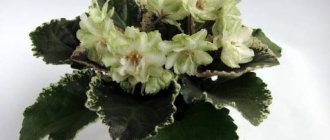Violet, description and photo Pink Watercolor (K. Morev)
Violets from breeders of the CIS countries - “R”.
Pink Watercolor (K. Morev).
Pink Watercolor, Rozovaia Akvarel (K. Morev).
Very large double and semi-double soft pink stars with a white “blurry” center, a soft ash pink spot in the center of each petal and a white wavy lace border.
A neat exhibition variegated leaf, green leaves with a thin white edge. Standard. The variegation of this variety is weakly expressed, the leaf is bordered by a white stripe along the edge. The rosette is large, but neat, although it hugs the pot.
Large white flowers with clear strokes of pink. The center is blurry, white, the edges look like a lacy white border. A flower with a very wavy edge. Sometimes this Saintpaulia is almost completely white, sometimes, on the contrary, it is very bright.
Flowering is very abundant and long lasting with an interval of 2-4 months. The flowers are really large, 5-7 cm, each lasts from 3 to 5 weeks.
The size of the flowers also depends on the air temperature; the cooler the room, the greater the difference between day and night temperatures, the larger and brighter the flowers.
Hardy and resistant variety. The variety is very easy to propagate and care for, very prolific, and always repeats itself from the leaf. With good lighting, the flowers will be really large. It does not like it when the leaves are removed; flowering is often delayed or becomes less abundant. Afraid of overwatering, watering very carefully, prone to fungal infections.
Watercolor (Latin aqua - water), paints (usually with vegetable glue) diluted with water, as well as painting with these paints. Its main qualities are: the transparency of the paints, through which the tone and texture of the base (mainly paper, rarely ivory silk) shine through, and the purity of color.
Do you know that…?
Reproduction of variegated violets. If it is a leaf from a variegated Saintpaulia variety, it should have quite a lot of green pigment on it. To propagate variegated violets, it is not recommended to use old or too young leaves. For planting, you need to choose the greenest leaves, where the variegation is expressed as little as possible; choose the greenest leaves that are possible. Leaf cuttings of variegated leaves with less than 30% green surface will either die during the rooting process, or do not produce offspring for a long time and then die anyway. 50% green is even better. Variegated violets are, perhaps, the only species (not counting chimeras) that are best purchased as children rather than cuttings. And if by cuttings, then at least two at once.
Before you buy the violets listed below, carefully read the forums about their behavior on the windowsill. Many of them are very beautiful flowers. However, these can be large rosettes with large and fragile leaves, with leaves rising up or hugging the pot, forming many stepsons that interfere with the formation of a neat rosette, pulling the stem up and growing into a Christmas tree, bending the trunk, rare flowering with long breaks, fallen flowers or they last little and quickly wither, very long and recumbent peduncles, the color of the flower fades quickly, they do not like bright lighting on the windowsill, they are afraid of the slightest drying out or waterlogging, a large percentage of them go into sports or darken the flower.
Features of home care
Violets are quite demanding to care for. The slightest mistake can lead to rotting of roots, greenery and other diseases of a similar nature.
Watering
You can water Saintpaulia in one of 3 ways:
- through the top, introducing moisture not at the root, but along the edge of the pot using a watering can with a long spout or a large syringe - water is poured into the pot until it seeps through the bottom of the pot and flows into the pan, which is then necessarily drained;
- through the pan - water is poured into the pan for 15–20 minutes, then the remaining moisture must be removed;
- using a wick - a wick made of synthetic fabric up to 2 cm thick is threaded into the bottom of the pot, directly into the drainage holes, and a tray of water is placed under the pot, into which the wick is lowered (the volume of the stand should be less than the volume of the bottom of the pot so that it does not come into contact with water).
Did you know? Violet is one of the most useful plants for the home. It does not cause allergies, looks great, and also releases phytoncides into the air, which help improve well-being and improve immunity.
Water for irrigation should be at room temperature, clean, and settled. Young violets need to be constantly moistened. Wick watering is perfect for this. It is enough to pour water into the pan once every 2 weeks. Mature plants require watering less often. It is optimal to moisten after the top layer of soil has dried to a depth of 0.5–1 cm. For adult plants, it is better to alternate adding water through the top and into the pan.
Periodically, the leaves need to be wiped from dust. It is better to do this with a damp cotton swab.
Top dressing
Saintpaulias have a long flowering period; accordingly, they consume a lot of nutrients and require year-round feeding. For this purpose, you can use fertilizers specifically designed for violets or ornamental plants. Fertilizers are applied once every 10–14 days in the appropriate dosage indicated on the label. When applying fertilizers intended for ornamental plants, the dosage should be reduced by half from that specified by the manufacturer.
Video: Feeding violets
At different stages of plant development, fertilizers should contain different concentrations of minerals:
- young plants are actively growing green mass, so the fertilizer should contain more nitrogen;
- When flowering and budding, plants need a lot of phosphorus and potassium, and nitrogen should be contained in minimal quantities.
Fertilizers cannot always be applied:
- within 30 days after transplantation;
- when the temperature is too high or low;
- in the presence of pests and diseases.
Feeding is applied in 2 ways:
- root;
- foliar.
Did you know? The largest violet flowers grow in soils rich in zinc. Thanks to this feature, it was possible to discover the largest zinc deposit in Europe.
The ideal option is to alternate these 2 methods. Fertilizer “Mr. Color” has proven itself quite well. Saintpaulia" (used during flowering - 1 cap / 2 liters of water) and "Mr. Universal" (used for growing green mass, roots and in between flowering - 1 cap/3 liters of water). Root feeding is best done by pouring liquid into a tray. All actions are similar to bottom watering. For root fertilizing, the concentration of the solution should be half that for root fertilizing.
Spraying on the leaf is carried out in cloudy weather or in the evening. Leaves must be clean. 1 hour after treatment, you need to make sure that there is no moisture on the leaves and in the rosette. If the liquid still remains somewhere, it must be removed using a tampon or sponge.
Trimming
When growing Saintpaulia, pruning is more of a sanitary nature and is carried out if the lower leaves:
- began to dry out;
- yellowed;
- stretched out greatly and thus spoil the appearance of the bush.
Manipulations are carried out manually, wearing gloves, after dipping your fingers in wood ash or activated carbon (crushed into powder). Healthy leaves can be used for propagation.
If there are too many new shoots, they can be cut out using small scissors pre-treated with alcohol, or simply pulled out of the soil. When pulling out the stepsons, the soil must be moist so that the main rosette is not damaged.
Transfer
Saintpaulia needs to be replanted between flowering periods. The ideal time is April-May. It is better to take a plastic pot - it is more mobile and retains moisture longer. The new pot should be 1 cm larger in diameter and height than the previous one, but three times smaller in diameter than the plant itself. The pot must have a sufficient number of fairly large drainage holes (0.5–1 cm). Replanting is carried out annually, because the plants bloom profusely and quickly deplete the soil.
Important! Violet is not afraid of re-rooting. If you remove some of the dried roots during transplantation, the plant will develop even better.
When transplanting, the earthen ball is replaced partially if this is a planned procedure, and completely if there is severe exposure of the stem due to diseases or damage by pests.
You can buy soil for violets in a store or make it yourself by mixing:
- 4 parts of turf-leaf soil;
- 1 part coarse sand;
- 1 part peat.
To this composition, sphagnum moss and wood ash are added to this composition to enrich the soil with nutrients. Before use, sphagnum moss is poured with boiling water for 15 minutes, then dried and crushed. To disinfect the soil, it is spilled with a weak solution of manganese and mixed thoroughly.
Sequence of transplantation:
- Water 24 hours before transplanting - the soil should be moist, but not stick to your hands.
- Disinfect the pot by treating it with boric acid.
- Place a layer of expanded clay mixed with perlite and sphagnum moss at the bottom of the pot.
- Place a layer of soil about 1 cm on top of the drainage.
- Carefully remove the plant from the old pot, shaking off the soil, which comes off easily.
- Place the plant in a new pot and fill the voids with soil, leveling the plant so that the lower leaves are almost in contact with the soil after repotting.
- Do not water after transplantation; it is better to cover the plant with polyethylene for a day to retain moisture and help it adapt to new conditions.
We advise you to learn more about the features of violet transplantation at home.
Pink Watercolor, K. Morev
Found a mistake? Report it: 1) Select the error with the mouse 2) Press CTRL+Enter. Read more.
Violet Pink Watercolor , K. Morev _
Large semi-double soft pink flowers with a white “blurry” center and a white lace border. Variegated leaf.
Violet EK Spring Watercolor
This gorgeous variety is another success in the field of creating new varieties of Uzambara violets by a breeder from Togliatti, Elena Vasilyevna Korshunova . Saintpaulia was presented for sale in 2005. Below you can see a photo of violets Spring watercolor.
Description of the variety
Saintpaulia is characterized by the independent formation of a compact, small-sized leaf rosette , which can be described as a standard type. The bush has a leveled contour, a symmetrical configuration and a high degree of fullness. This is a correct example of a show rosette.
Not very large in size, elongated - heart-shaped leaf plates are distinguished by shades of lush greenery with a salad venation pattern, rounded - notched serration and a wavy configuration of the lateral edge, as well as a smooth, matte surface structure.
Violet produces a very long flowering of the cap type with the formation of a huge number of buds of medium diameter. Strong peduncles easily support a significant mass of flowers in an erect position, preventing them from scattering over the leaves of the rosette.
Saintpaulia corollas with double and semi-double degrees of fullness acquire additional volume due to the wavy structure of the tips of the petals and the abundant fringed edging. The main tone of the flowers is maintained in the tints of pink , shaded by a purple-crimson coating along the edge of the petals and a light green fringe color with golden sparkles.
Sports
Saintpaulia can quite often form sports:
- with a darker color of the main pink background and spraying along the edges;
- with a predominance of greenish color and an increase in the volume of fringe.
Features of maintenance and care
Saintpaulia is an almost problem-free plant to keep in indoor collections for both experienced gardeners and novice lovers of tropical beauties:
- the variety itself forms a leaf rosette that has exhibition characteristics;
- does not require special conditions of detention, but adapts to the proposed microclimate ;
- blooms for long periods of time with chic caps.
The variety has one negative feature - shredding of the corollas as the number of flowering increases. Bush rejuvenation can help with this.
Reviews
For me, a big plus is the violet’s ability to independently form its own rosette. Well, I don’t like all the problems associated with the formation of a decorative bush. That’s why I buy independent specimens for my collection.”
Properties
Name
- Original: Pink Watercolor
Registration
- Selection: Morev K.
- Year: 2006
Socket
- Socket type: standard
Flower
- Flower size, up to: 6 cm
- Terry size: semi-double, terry
- Main Color: Pink and White
- Color type: two-tone
- Border: light
- Other features: wavy flower edges
Foliage
- foliage color: dark green
- foliage type: simple
- foliage shape: pointed
- leaf edge: jagged edge
- variegation: bordering (Tommy Lowe)
Characteristics and description of the plant
The author of the Pink Watercolor variety is Konstantin Morev. This man has been breeding violets since 1994 and has already developed many different varieties that are distinguished by their unusual appearance and quality, sometimes even exceeding modern American varietal specimens. Much attention in his works is paid to clearly defined brush strokes in the shades of violet petals.
The bushes of these flowers are small, up to 15 cm in height. The leaves are dense, green in color, on thick petioles. The veins are clearly visible on the inside of the leaf plates. The outer side of the leaf is darker in color and covered with a layer of soft transparent hairs.
The variety got its name due to the unusual coloring of the white petals, on which strokes are clearly visible, as if specially left with a brush with watercolor paint. The flowers are large, up to 6 cm in diameter. The core and border are white only if the temperature is maintained within +20°C, but when raised to +25°C and above, the flowers become completely pink.
Flowering is long-lasting and, when optimal conditions are created, is 10 months a year with a break of 1–2 months. It begins to bloom for the first time in June and ends in September-October, the second time flowering begins in winter, in December, and ends in March-April. The second flowering may not occur if the room temperature is too low.
Peculiarities
A very neat variegated leaf.
The leaf is dark, and the light bordering white stripe on the edge of the leaf gives the foliage a special charm and makes each leaf lighter. Pink Watercolor is a bright beauty, each flower is wavy, like an airy summer dress that the wind blows in a dance. Large white flowers with clear strokes of pink, as if an artist painted each flower with watercolors.
This variety has a long flowering period.
Light is important in care, then the flowers will be really large. The size of the flowers also depends on the air temperature; the cooler the room, the greater the difference between day and night temperatures, the larger and brighter the flowers. The variety really does not like when the leaves are removed; flowering is often delayed or becomes less abundant.
Conditions for growing violets at home
For full development, Saintpaulias need certain conditions that will be as close to natural as possible.
Of particular importance are:
- lighting quality;
- temperature;
- humidity.
Placement and lighting
Violets need a lot of diffused light and high-quality shading from direct sunlight. Incorrect light conditions worsen the quality of flowering, and may even cause its absence. The optimal distance to the light source should be 30–40 cm. Violets need a long daylight hours—10–12 hours.
Temperature and humidity
The optimal temperature for year-round cultivation of Saintpaulia is +18. +20°C. With this mode, you can achieve long-lasting double flowering. In the summer months, violets feel good at a temperature of +28°C, but bloom less profusely. In winter, a short-term decrease in night temperatures to +12°C is permissible, but not more than 2–3 days in a row. Otherwise, the plants may die from freezing.
Air humidity should be 50–75%. If necessary, the space around the plant can be moistened with a spray bottle, but this must be done with great care. A good option is to place violets in close proximity to plants that actively evaporate moisture: this way it will be possible to create a natural symbiosis, as in natural conditions.
Pink watercolor
Saintpaulia of this delicate color was not created just like that. From time immemorial, pink has symbolized harmony between passion and innocence; it is the color of contradiction in love, feelings and femininity. That is why flowers of this shade have always been highly valued. Pink watercolor is a uniquely beautiful variety, with very large flowers (double) of pale pink color. The center is blurry, white, the edges look like a lacy white border. This is the K. Moreva variety. It is called graceful variegated leaf.
Each leaf is bordered by a white stripe along the edge, although it itself is dark. This makes the plant even more delicate and original. The airy waviness of the petals appeals to many collectors. The name is associated with the peculiarity of the color: pink strokes are visible on the white flowers, as if painted with an artist’s brush. Sometimes this Saintpaulia is almost completely white, sometimes, on the contrary, it is very bright.
It blooms for a very long time, and in excellent light it will produce large flowers more than six centimeters in diameter. Their value is also affected by the ambient temperature. Pink watercolor likes cool, and the brightness increases as the difference between the air temperature at night and day increases.
Removing leaves is not recommended: this procedure can delay the onset of flowering for a long time or make it less lush, abundant and beautiful. If you strictly adhere to all the rules of caring for the plant, then this Saintpaulia will be a lush, graceful and elegant beauty in the owner’s collection.
Violets on the windowsill - signs
Violets on the windowsill ruin your privacy
The incredible popularity of Saintpaulia has become the reason for many superstitions and signs with which this flower is associated. They say, for example, that the violet is a muzhegon, that is, an unmarried woman who grows indoor violets supposedly has no chance of getting married, and a married Saintpaulia lover runs the risk of being left without a husband. But if you think carefully, it turns out that among your friends there are married women who have been growing violets for years. And even those of your friends who got married not so long ago can find a violet or two on the windowsill. If you look.
Another superstition states that the indoor violet is an energy vampire and that you should not keep it in your bedroom because it causes drowsiness and loss of energy. But, if you think about it, violets, like any other plants, produce oxygen during the day, in the light, and at night, on the contrary, they absorb it and release carbon dioxide. And the lack of oxygen makes you sleepy. Hence the conclusion: there is no need to arrange a whole greenhouse on the windowsill in the bedroom.
Violets are good omens
But astrologers believe that violet, combining the energy of Taurus and the Moon, has a calming effect on a person, bringing comfort and good mood to the house. And like all flowers belonging to the sign of Taurus, they have the power of a talisman, guaranteeing security, stability, harmony and endowing a person with wisdom, endurance and inspiration in creativity. Like this…
Pink Panther
Saintpaulia variety Pink Panther belongs to the selection of K. Morev. Panther has large flowers, light pink in color, with a large white edge. The leaves are not dark, but not light either, scalloped, slightly pointed.
Some features of caring for violets of the Panther variety:
- If the rosette is exposed to excessive light, the color may become more pink, “floating” onto the white border and making the color generally more washed out;
- Also, a common problem when growing the Panther variety is too many leaves - this is often also related to lighting;
- During the first flowering, there are often no iridescent shades observed - the petals are completely pink;
- Leaves become denser when exposed to excess light;
- The wait for flowers may be delayed - the Panther is not a fast subspecies in this regard.
Often, collectors grow two varieties together: Saintpaulia Blue Mist and Panther. They are similar in foliage shape, look good next to each other, and the rules for caring for them are very similar. They cannot be overheated or overexposed, but otherwise the Panther is not at all capricious, according to reviews from amateurs.
Diseases and harmful insects
The main difficulty that arises when growing Saintpaulia is that the plant does not bloom.
The difficulty may be associated with: illiterate care, but it is easy to fix; diseases of various types; harmful insects.
Widespread diseases of violets of the Pink Watercolor variety
- Downy mildew. Brown spots appear and dry out, and the elasticity of the leaves is lost. Healthy fragments are separated, and rooted and diseased parts are removed along with the soil. All crops located next to violets are treated as with fusarium.
- Root and leaf rot. The leaves lose their elasticity, the color of the rosette changes, the petioles and foliage dry out and become watery. It is necessary to quickly remove all damaged fragments and root the healthy part. To prevent rot from appearing a second time, before rooting the flower, it is treated with a solution of ash with the drug “Fundazol” in a 1: 1 ratio - the bush is sprayed or crushed with a dry agent. This solution is used for prophylaxis during transplantation.
- Dust mold. The disease is caused by fungal spores that develop in high moisture content and weak vegetation. The damaged fragments are completely removed and the flower is treated with Fundazol.”
- Fusario. This is also a disease caused by a fungus. It practically does not heal; therefore, the bush is destroyed along with the soil, and other vegetation that was next to the violet is treated with Fundazol, which is mixed with ash in a 1: 1 ratio.
- Viral diseases. No treatment. The bushes are destroyed along with the soil.
Harmful insects.
- Cochineal. They fight just like aphids.
- Cyclamen mite. Diseased bushes are isolated in advance, infected fragments are removed, and the sections are treated with ash. Flowers are also treated with Fitoverm according to the recipe two or three times.
- Aphid. Eliminate it with a solution of tobacco dust. The solution sprays onto the leaves and replaces the top water.
- Thrips. They fight with a solution of the drug "Aktara" (add one or two drops of the product to three liters of water), treat leaves, flower stems and soil.
- Sciaridi. Get rid of them with the drug "Aktara", the dosage is the same as when fighting thrips.
Prevention of diseases and harmful insects.
- When purchasing new Saintpaulias, it is mandatory to organize a quarantine zone, in which there is no other vegetation in the room, for the entire month.
- It is necessary to strictly control soil moisture and temperature.
- Feed the plants in a timely manner based on their age.
- Soil prevention is carried out with a solution of ash and the drug “Fundazol” once or twice a year.
Pink marshmallow
Violets of this variety are distinguished by variegated rosettes, lush flowers, double appearance, and very bright (light crimson) color of the petals. The species was bred by Lebetskaya. It is quite rare, but very beautiful. Terry stars look like a plentiful, lush cap above the leaves. The leaves are even, variegated - with a delicate white border along the edge of the dark green leaf. One flower reaches 5-6 centimeters, the whole plant looks compact.
Zephyr has very strong peduncles that stand upright. The flowers are light when they first bloom and darken over time. The maximum diameter is six and a half centimeters. Saintpaulia of this variety looks classic, without play or multicolor, and the variegation of the leaves adds elegance to it.
Young foliage can be very light. In general, Zephyr can be quite different under different conditions. Brightness is primarily affected by lighting, which is why Marshmallow often turns out pale and tender. These flowers look more like small roses than violets. Zephyr blooms a lot of foliage, but it does not interfere with the growth of flowers, but, on the contrary, emphasizes the colors. In the first flowering, doubleness may not appear. Saturation is added as one blooms - from beginning to end.
Violet EK Radiant Watercolor
The spectacular variety represents the breeding research of the Togliatti master to improve the varietal and decorative characteristics of Saintpaulia Elena Vasilyevna Korshunova. The violet first appeared at flower shows in 2016.
Next, we will look in detail at what the Radiant watercolor violet is; you will find a photo and description of it in the following subsections.
Description of the variety
Due to the average size of the leaf rosette, violet can be classified according to the standard type. The bush forms a very compact rosette with an aligned configuration and dense filling, which has an unusually round shape . Saintpaulia is a prime example of a classic show rosette.
Violet leaf blades have a rounded configuration, a clear venation pattern with a lighter central vein, a rounded-toothed structure of the lateral edge, a matte surface structure and a color with a rich tonality of summer greenery. In young specimens, the shade of the leaves may be somewhat lighter, reminiscent of spring green grass.
Violet flowering occurs in a bouquet type with the formation of a significant number of simultaneously formed buds. Due to this feature of the variety, the duration of preservation of the decorative appearance of the bouquet increases significantly.
The corollas are distinguished by their large size, semi-double fullness , the volume of which looks much larger due to the wavy structure of the edge of each petal and white tonality with vague watercolor spots of a bluish color located in the center of the petals.
Sports
The appearance of sports specimens of the variety has not yet been noticed.
Features of maintenance and care
Saintpaulia "EK Radiant Watercolor" is an object of constant demand and unabating interest of flower growers at all exhibitions.
The variety is suitable for growing in the collections of experienced gardeners and amateur beginners , as it does not require special maintenance conditions, grows easily and quickly, blooms magnificently and effectively.
The unusual color of the corollas provokes the appearance of a slight nuance when growing violets. This is the dependence of the color intensity of the spots on light and temperature:
- in bright light the richness of the color pattern decreases;
- at high temperatures the color tone becomes thicker.
Reviews
“EK Radiant Watercolor” conducted an experiment with Saintpaulia: she placed one bush on the windowsill, the other on the bottom shelf of the rack. On the window, in bright light, the bush acquired too delicate shades, and the specimen from the rack was decorated with rich blue spots in a narrow white frame. Light greatly affects the color of the variety’s buds.”
Pink Dalmatian
Saintpaulia variety Pink Dalmatian was bred by breeder Korshunova. This incredibly interesting color – lilac-pinkish flowers with a contrasting fantasy pattern in the form of purple or lilac-raspberry spots on double petals – gained popularity among collectors very quickly.
The foliage of the Dalmatian is rich, the leaves are simple, even and neat. The dark color is emphasized by the brightness of the flowers. Sports of this subspecies sometimes turn out to be contrasting, white and purple, but also very beautiful.
The fantasy of a drawing can be difficult to convey to children. But with proper transplants and seating arrangements, no problems arise. Elegant flowers decorate the collection, distinguished by intricate petal patterns. Fantasy flowers are not only dark lilac, but even eggplant. The only thing this variety lacks is variegation. Otherwise, this Saintpaulia is very good both in care and in appearance.
Saintpaulia in different shades of pink is an original flower that stands out brightly among many others. This is probably why every violet lover’s collection includes at least one of the above subspecies.
How to propagate at home
Saintpaulia is propagated at home in 2 ways:
- cuttings;
- dividing the bush.
Cuttings
The cuttings are Saintpaulia leaves. The lower healthy leaves removed during pruning are suitable for propagation. After trimming, having selected the most attractive specimens, they are placed in a glass of water, after adding 1 drop of hydrogen peroxide and an activated carbon tablet.
Video: Violet propagation by leaf
The water is changed periodically and wait for the roots to appear.
Once they are formed, you can plant them in the ground. It is prepared as for adult plants. The pots are small, with a diameter and height of 5 cm. Read in more detail the step-by-step instructions for propagating violets by leaf.
Dividing the bush
By dividing the bush, violets are propagated when transplanting, if the plant has produced side children - small bushes with several leaves growing from the soil. After removal from the soil, the bush is carefully divided by hand; usually this is not difficult.
If the roots are tightly intertwined, you can use scissors treated with alcohol. Young plants are planted in small containers of suitable volume. Cover the pots with polyethylene for a day to create a greenhouse effect.
Contents in room culture
Violet Moreva Pink Watercolor, in order to preserve the spectacular decorative structure of its flowers and maintain the general level of health in the microclimate of the room, the collection will be grateful for the regular implementation of the usual care regimens , adjusted for small nuances of keeping variegated leaves:
- It is best to display violets ; the northern direction of the window necessarily requires additional light from the artificial spectrum, and the southern window always predetermines the creation of a small shadow for the violet;
- Watering is carried out in small portions, and always after light preliminary drying of the upper tier of the substrate;
- The appearance of the violet will indicate the need to apply mineral fertilizers
- Lighting needs to be long-lasting, natural, diffuse;
- Temperature - within +18 + 20°C without jumps or changes;
- The soil in the flowerpot is rich, well aerated, and permeable; with a volumetric drainage system;
Saintpaulia requires proper care.
The presented violet inspires thousands of flower growers.











